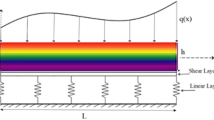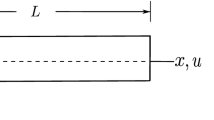Abstract
In this article, a geometrically exact flexoelectric beam model and its weak form quadrature element formulation are established. The coupling of strain gradient and electric field in flexoelectricity involving size effects is taken into account and the resulting C1 continuity requirements are satisfied. The formulation owns the advantage of high-order approximation to circumvent locking problems after discretization. Several numerical examples originating from benchmark nonlinear beam problems are studied to validate the feasibility of the formulation. Compared to existing flexoelectric beam models, the use of geometrically exact beam theory in the present model makes an innovative contribution to analyzing flexoelectric microbeams undergoing large displacements and rotations. This study is a step forward to better understandings of flexoelectric effects on microbeams under large deflections, while also providing a viable approach to predict their nonlinear behaviors in such conditions.















Similar content being viewed by others
References
Zubko, P., Catalan, G., Tagantsev, A.K.: Flexoelectric effect in solids. Annu. Rev. Mater. Sci. 43, 387–421 (2013)
Yudin, P., Tagantsev, A.: Fundamentals of flexoelectricity in solids. Nanotechnology 24(43), 432001 (2013)
Kundalwal, S., Meguid, S., Weng, G.: Strain gradient polarization in graphene. Carbon 117, 462–472 (2017)
Majdoub, M., Sharma, P., Çağin, T.: Dramatic enhancement in energy harvesting for a narrow range of dimensions in piezoelectric nanostructures. Phys. Rev. B 78(12), 121407 (2008)
Majdoub, M., Sharma, P., Cagin, T.: Enhanced size-dependent piezoelectricity and elasticity in nanostructures due to the flexoelectric effect. Phys. Rev. B 77(12), 125424 (2008)
Mindlin, R.D.: Polarization gradient in elastic dielectrics. Int. J. Solids Struct. 4(6), 637–642 (1968)
Sahin, E., Dost, S.: A strain-gradients theory of elastic dielectrics with spatial dispersion. Int. J. Eng. Sci. 26(12), 1231–1245 (1988)
Maranganti, R., Sharma, N., Sharma, P.: Electromechanical coupling in nonpiezoelectric materials due to nanoscale nonlocal size effects: Green’s function solutions and embedded inclusions. Phys. Rev. B 74(1), 014110 (2006)
Shen, S., Hu, S.: A theory of flexoelectricity with surface effect for elastic dielectrics. J. Mech. Phys. Solids 58(5), 665–677 (2010)
Liu, L.: An energy formulation of continuum magneto-electro-elasticity with applications. J. Mech. Phys. Solids 63, 451–480 (2014)
Rupa, N.S., Ray, M.C.: Analysis of flexoelectric response in nanobeams using nonlocal theory of elasticity. Int. J. Mech. Mater. Des. 13(3), 453–467 (2017)
Ebrahimi, F., Karimiasl, M.: Nonlocal and surface effects on the buckling behavior of flexoelectric sandwich nanobeams. Mech. Adv. Mater. Struct. 25(11), 943–952 (2018)
Ebrahimi, F., Karimiasl, M., Civalek, Ö., Vinyas, M.: Surface effects on scale-dependent vibration behavior of flexoelectric sandwich nanobeams. Adv. Nano Res. 7(2), 77 (2019)
Ebrahimi, F., Karimiasl, M., Singhal, A.: Magneto-electro-elastic analysis of piezoelectric–flexoelectric nanobeams rested on silica aerogel foundation. Eng. Comput. 37, 1007–1014 (2021)
Shariati, A., Ebrahimi, F., Karimiasl, M., Vinyas, M., Toghroli, A.: On transient hygrothermal vibration of embedded viscoelastic flexoelectric/piezoelectric nanobeams under magnetic loading. Adv. Nano Res. 8(1), 49–58 (2020)
Zhang, D., Lei, Y., Adhikari, S.: Flexoelectric effect on vibration responses of piezoelectric nanobeams embedded in viscoelastic medium based on nonlocal elasticity theory. Acta Mech. 229(6), 2379–2392 (2018)
Qu, Y., Jin, F., Yang, J.: Buckling of flexoelectric semiconductor beams. Acta Mech. 232(7), 2623–2633 (2021)
Wang, K.F., Wang, B.L.: Non-linear flexoelectricity in energy harvesting. Int. J. Eng. Sci. 116, 88–103 (2017)
Zarepour, M., Hosseini, S., Akbarzadeh, A.: Geometrically nonlinear analysis of Timoshenko piezoelectric nanobeams with flexoelectricity effect based on eringen’s differential model. Appl. Math. Model. 69, 563–582 (2019)
Baroudi, S., Najar, F.: Dynamic analysis of a nonlinear nanobeam with flexoelectric actuation. J. Appl. Phys. 125(4), 044503 (2019)
Zhong, H., Yu, T.: Flexural vibration analysis of an eccentric annular Mindlin plate. Arch. Appl. Mech. 77(4), 185–195 (2007)
Zhong, H., Yu, T.: A weak form quadrature element method for plane elasticity problems. Appl. Math. Model. 33(10), 3801–3814 (2009)
Bellman, R., Casti, J.: Differential quadrature and long-term integration. J. Math. Anal. Appl. 34(2), 235–238 (1971)
Striz, A.G., Weilong, C., Bert, C.W.: Static analysis of structures by the quadrature element method (QEM). Int. J. Solids Struct. 31(20), 2807–2818 (1994)
Zhong, H., Zhang, R., Xiao, N.: A quaternion-based weak form quadrature element formulation for spatial geometrically exact beams. Arch. Appl. Mech. 84(12), 1825–1840 (2014)
Zhang, R., Zhong, H.: A quadrature element formulation of an energy-momentum conserving algorithm for dynamic analysis of geometrically exact beams. Comput. Struct. 165, 96–106 (2016)
Zhang, R., Zhong, H.: A weak form quadrature element formulation for geometrically exact thin shell analysis. Comput. Struct. 202, 44–59 (2018)
Zhang, R., Zhong, H., Yao, X., Han, Q.: A quadrature element formulation of geometrically nonlinear laminated composite shells incorporating thickness stretch and drilling rotation. Acta Mech. 231(5), 1685–1709 (2020)
Zhang, R., Stanciulescu, I., Yao, X., Zhong, H.: An energy-momentum conserving scheme for geometrically exact shells with drilling dofs. Comput. Mech. 67(1), 341–364 (2021)
Simo, J.C.: A finite strain beam formulation. The three-dimensional dynamic problem. part i. Comput. Methods Appl. Mech. Eng. 49(1), 55–70 (1985)
Simo, J.C., Vu-Quoc, L.: A three-dimensional finite-strain rod model. Part ii: computational aspects. Comput. Methods Appl. Mech. Eng. 58(1), 79–116 (1986)
Aifantis, E.C.: On the role of gradients in the localization of deformation and fracture. Int. J. Eng. Sci. 30(10), 1279–1299 (1992)
Codony, D., Gupta, P., Marco, O., Arias, I.: Modeling flexoelectricity in soft dielectrics at finite deformation. J. Mech. Phys. Solids 146, 104182 (2021)
Shu, C., Richards, B.E.: Application of generalized differential quadrature to solve two-dimensional incompressible Navier–Stokes equations. Int. J. Numer. Methods Fluids 15(7), 791–798 (1992)
Auricchio, F., Carotenuto, P., Reali, A.: On the geometrically exact beam model: a consistent, effective and simple derivation from three-dimensional finite-elasticity. Int. J. Solids Struct. 45(17), 4766–4781 (2008)
Liang, X., Hu, S., Shen, S.: Effects of surface and flexoelectricity on a piezoelectric nanobeam. Smart Mater. Struct. 23(3), 035020 (2014)
Deng, F., Deng, Q., Yu, W., Shen, S.: Mixed finite elements for flexoelectric solids. J. Appl. Mech. 84(8), 081004 (2017)
Sladek, J., Sladek, V., Hosseini, S.M.: Analysis of a curved Timoshenko nano-beam with flexoelectricity. Acta Mech. 232(4), 1563–1581 (2021)
Davis, P.J., Rabinowitz, P.: Methods of Numerical Integration. Courier Corporation, Chelmsford (2007)
Balobanov, V., Niiranen, J.: Locking-free variational formulations and isogeometric analysis for the Timoshenko beam models of strain gradient and classical elasticity. Comput. Methods Appl. Mech. Eng. 339, 137–159 (2018)
De Borst, R., Crisfield, M.A., Remmers, J.J.C., Verhoosel, C.V.: Non-linear Finite Element Analysis of Solids and Structures, 2nd edn. Wiley, Hoboken (2012)
Chapelle, D., Bathe, K.-J.: The Finite Element Analysis of Shells-fundamentals. Springer, Berlin (2010)
Canuto, C., Hussaini, M.Y., Quarteroni, A., Zang, T.A.: Spectral Methods: Fundamentals in Single Domains. Springer, Berlin (2007)
Meier, C., Popp, A., Wall, W.A.: An objective 3d large deformation finite element formulation for geometrically exact curved Kirchhoff rods. Comput. Methods Appl. Mech. Eng. 278, 445–478 (2014)
Herath, S., Yin, G.: On the geometrically exact formulations of finite deformable isogeometric beams. Comput. Mech. 67(6), 1705–1717 (2021)
Jelenic, G., Crisfield, M.: Geometrically exact 3d beam theory: implementation of a strain-invariant finite element for statics and dynamics. Comput. Methods Appl. Mech. Eng. 171(1–2), 141–171 (1999)
Bauer, A., Breitenberger, M., Philipp, B., Wüchner, R., Bletzinger, K.-U.: Nonlinear isogeometric spatial Bernoulli beam. Comput. Methods Appl. Mech. Eng. 303, 101–127 (2016)
Vo, D., Nanakorn, P., Bui, T.Q.: Geometrically nonlinear multi-patch isogeometric analysis of spatial Euler–Bernoulli beam structures. Comput. Methods Appl. Mech. Eng. 380, 113808 (2021)
Wang, B., Zhao, J., Zhou, S.: A micro scale Timoshenko beam model based on strain gradient elasticity theory. Eur. J. Mech. A. Solids 29(4), 591–599 (2010)
Acknowledgements
The present investigation was performed with the support of the National Natural Science Foundation of China (No. 12172136), the Science and Technology Project of Guangzhou (No. 202102020656).
Author information
Authors and Affiliations
Corresponding author
Additional information
Publisher's Note
Springer Nature remains neutral with regard to jurisdictional claims in published maps and institutional affiliations.
Appendices
Appendix A Constitutive and element tangent stiffness matrix
1.1 Constitutive matrix
By denoting the initial shear-axial strain vector and bending-torsional strain vector as \(\varvec{\gamma }_0\) and \(\varvec{\kappa }_0\), the stress resultant \({\textbf{n}}\), \({\textbf{m}}\) and the double stress resultant \({\tilde{\textbf{n}}}\), \({\tilde{\textbf{m}}}\) in Eq. (31) are given by
with
where \(k_{s1}\) and \(k_{s2}\) are the shear correction factors; \(I_1\) and \(I_2\) are the corresponding principal bending inertial moments of the cross section; and \(J_{sv}\) is the torsional inertial moment.
1.2 Element tangent stiffness matrix
According to the definition in Eq. (58), the element tangent stiffness matrix is derived as
where \({{\textbf{D}}}_{\text { I}}\), \({{\textbf{D}}}_{\text { II}}\) and \({{\textbf{D}}}_{\text { III}}\) are defined as
\({{\mathbf {\Xi }}_i}\) and \({\overline{\mathbf {\Xi }} _i}\) are given by
Appendix B Analytical solutions for the simply-supported beam
We consider a plane simply-supported beam with the governing equation Eq. (37) reduced as
where \(u_1\) is the deflection and \(\varphi \) denotes the rotation. p and m are the external distributed force and moment, respectively. Referring to previous works [40, 49] for strain gradient beams, the following boundary conditions
are employed. The deflection \(u_1\) and rotation \(\varphi \) are assumed to take the following Fourier series
where \(U_n\) and \(\Phi _n\) are Fourier coefficients to be determined for each n. External load is taken as
with a constant \(p_0\). According to Eqs. (B1), (B3) and (B4), after somewhat straightforward calculations, the final expression of \(u_1\) and \(\varphi \) is given as
with
where \(\beta =\pi /L\).
Rights and permissions
Springer Nature or its licensor (e.g. a society or other partner) holds exclusive rights to this article under a publishing agreement with the author(s) or other rightsholder(s); author self-archiving of the accepted manuscript version of this article is solely governed by the terms of such publishing agreement and applicable law.
About this article
Cite this article
Cheng, J., Zhang, R., Chen, T. et al. A numerical scheme for geometrically exact flexoelectric microbeams using the weak form quadrature element method. Acta Mech 235, 991–1013 (2024). https://doi.org/10.1007/s00707-023-03787-w
Received:
Revised:
Accepted:
Published:
Issue Date:
DOI: https://doi.org/10.1007/s00707-023-03787-w




